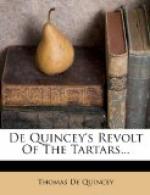The family life was sadly broken in 1837 by the death of De Quincey’s wife. He who was now left as guardian of the little household of six children, was himself so helpless in all practical matters that it seemed as though he were in their childish care rather than protector of them. Scores of anecdotes are related of his odd and unpractical behavior. One of his curious habits had been the multiplication of lodgings; as books and manuscripts accumulated about him so that there remained room for no more, he would turn the key upon his possessions and migrate elsewhere to repeat the performance later on. It is known that as many as four separate rents were at one and the same time being paid by this odd, shy little man, rather than allow the disturbance or contraction of his domain. Sometimes an anxious journey in search of a manuscript had to be made by author and publisher in conjunction before the missing paper could be located. The home life of this eccentric yet lovable man of genius seems to have been always affectionate and tender in spite even of his bondage to opium; it was especially beautiful and childlike in his latest years. His eldest daughter, Margaret, assumed quietly the place of headship, and with a discretion equal to her devotion she watched over her father’s welfare. With reference to De Quincey’s circumstances at this time, his biographer, Mr. Masson, says: “Very soon, if left to himself, he would have taken possession of every room in the house, one after another, and ‘snowed up’ each with his papers; but, that having been gently prevented, he had one room to work in all day and all night to his heart’s content. The evenings, or the intervals between his daily working time and his nightly working time, or stroll, he generally spent in the drawing-room with his daughters, either alone or in company with any friends that chanced to be with him. At such times, we are told, he was unusually charming. ’The newspaper was brought out, and he, telling in his own delightful way, rather than reading, the news, would, on questions from this one or that one of the party, often including young friends of his children, neighbors, or visitors from distant places, illuminate the subject with such a wealth of memories, of old stories of past or present experiences, of humor, of suggestion, even of prophecy, as by its very wealth makes it impossible to give any taste of it.’ The description is by




